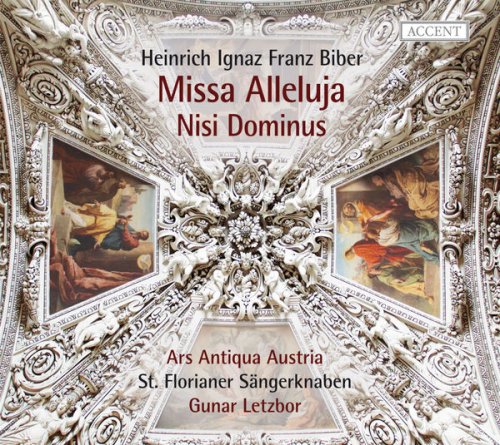
St. Florianer Sängerknaben, Ars Antiqua Austria & Gunar Letzbor - Missa Alleluja (2017)
BAND/ARTIST: St. Florianer Sängerknaben, Ars Antiqua Austria, Gunar Letzbor
- Title: Missa Alleluja
- Year Of Release: 2017
- Label: Accent
- Genre: Classical, Sacred
- Quality: flac lossless +booklet
- Total Time: 00:59:08
- Total Size: 301 mb
- WebSite: Album Preview
Tracklist
---------
01. Missa Alleluja: Kyrie - St. Florianer Sängerknaben
02. Missa Alleluja: Gloria - St. Florianer Sängerknaben
03. Missa Alleluja: In Gloria Dei Patris - St. Florianer Sängerknaben
04. Missa Alleluja: Credo - St. Florianer Sängerknaben
05. Missa Alleluja: Et incarnatus - St. Florianer Sängerknaben
06. Missa Alleluja: Crucifixus - St. Florianer Sängerknaben
07. Missa Alleluja: Et resurexit - St. Florianer Sängerknaben
08. Missa Alleluja: Et in spiritum sanctum - St. Florianer Sängerknaben
09. Missa Alleluja: Sanctus - St. Florianer Sängerknaben
10. Missa Alleluja: Osanna I - St. Florianer Sängerknaben
11. Missa Alleluja: Benedictus - St. Florianer Sängerknaben
12. Missa Alleluja: Osanna II - St. Florianer Sängerknaben
13. Missa Alleluja: Agnus Die - St. Florianer Sängerknaben
14. Missa Alleluja: Dona nobis pacem - St. Florianer Sängerknaben
15. Nisi Dominus aedificaverit domum "Psalm 127" - Gerd Kenda
16. Violin Sonata in A Major, C. 106 "Pastorella" - Gunar Letzbor
17. Hic est panis - Gerd Kenda
Several masses scored for large forces attest to the outstanding compositional skills of the Salzburg master Heinrich Ignaz Franz Biber (1644-1704). For Salzburg Cathedral, Biber prepared polychoric pieces modelled on the grand performance practice in Venice.
The Missa Alleluja was probably composed after 1690 and certainly before 1698: the original score from Salzburg is lost but excellent copies have been preserved at the Upper Austrian abbey at Kremsmünster, which serve as a basis for the present recording. Biber fully exploited the possibilities of Baroque instrumentation in the Missa Alleluja: a chorus with 2 sopranos, 2 altos, 2 tenors and 2 bass voices grants him a large number of combinations of voices and thus constant changes of timbre. The strings 'choir' also has six parts, with both violins often written virtuosically. A 'chorus' of 3 trumpets and 2 cornetti is even surpassed in tonal mass by that composed of 2 clarinets, 4 trumpets and timpani. This large number of trumpets emphasises the cheerful character of the work and is luxurious by Austrian standards.
---------
01. Missa Alleluja: Kyrie - St. Florianer Sängerknaben
02. Missa Alleluja: Gloria - St. Florianer Sängerknaben
03. Missa Alleluja: In Gloria Dei Patris - St. Florianer Sängerknaben
04. Missa Alleluja: Credo - St. Florianer Sängerknaben
05. Missa Alleluja: Et incarnatus - St. Florianer Sängerknaben
06. Missa Alleluja: Crucifixus - St. Florianer Sängerknaben
07. Missa Alleluja: Et resurexit - St. Florianer Sängerknaben
08. Missa Alleluja: Et in spiritum sanctum - St. Florianer Sängerknaben
09. Missa Alleluja: Sanctus - St. Florianer Sängerknaben
10. Missa Alleluja: Osanna I - St. Florianer Sängerknaben
11. Missa Alleluja: Benedictus - St. Florianer Sängerknaben
12. Missa Alleluja: Osanna II - St. Florianer Sängerknaben
13. Missa Alleluja: Agnus Die - St. Florianer Sängerknaben
14. Missa Alleluja: Dona nobis pacem - St. Florianer Sängerknaben
15. Nisi Dominus aedificaverit domum "Psalm 127" - Gerd Kenda
16. Violin Sonata in A Major, C. 106 "Pastorella" - Gunar Letzbor
17. Hic est panis - Gerd Kenda
Several masses scored for large forces attest to the outstanding compositional skills of the Salzburg master Heinrich Ignaz Franz Biber (1644-1704). For Salzburg Cathedral, Biber prepared polychoric pieces modelled on the grand performance practice in Venice.
The Missa Alleluja was probably composed after 1690 and certainly before 1698: the original score from Salzburg is lost but excellent copies have been preserved at the Upper Austrian abbey at Kremsmünster, which serve as a basis for the present recording. Biber fully exploited the possibilities of Baroque instrumentation in the Missa Alleluja: a chorus with 2 sopranos, 2 altos, 2 tenors and 2 bass voices grants him a large number of combinations of voices and thus constant changes of timbre. The strings 'choir' also has six parts, with both violins often written virtuosically. A 'chorus' of 3 trumpets and 2 cornetti is even surpassed in tonal mass by that composed of 2 clarinets, 4 trumpets and timpani. This large number of trumpets emphasises the cheerful character of the work and is luxurious by Austrian standards.
Year 2017 | Classical | FLAC / APE
As a ISRA.CLOUD's PREMIUM member you will have the following benefits:
- Unlimited high speed downloads
- Download directly without waiting time
- Unlimited parallel downloads
- Support for download accelerators
- No advertising
- Resume broken downloads


